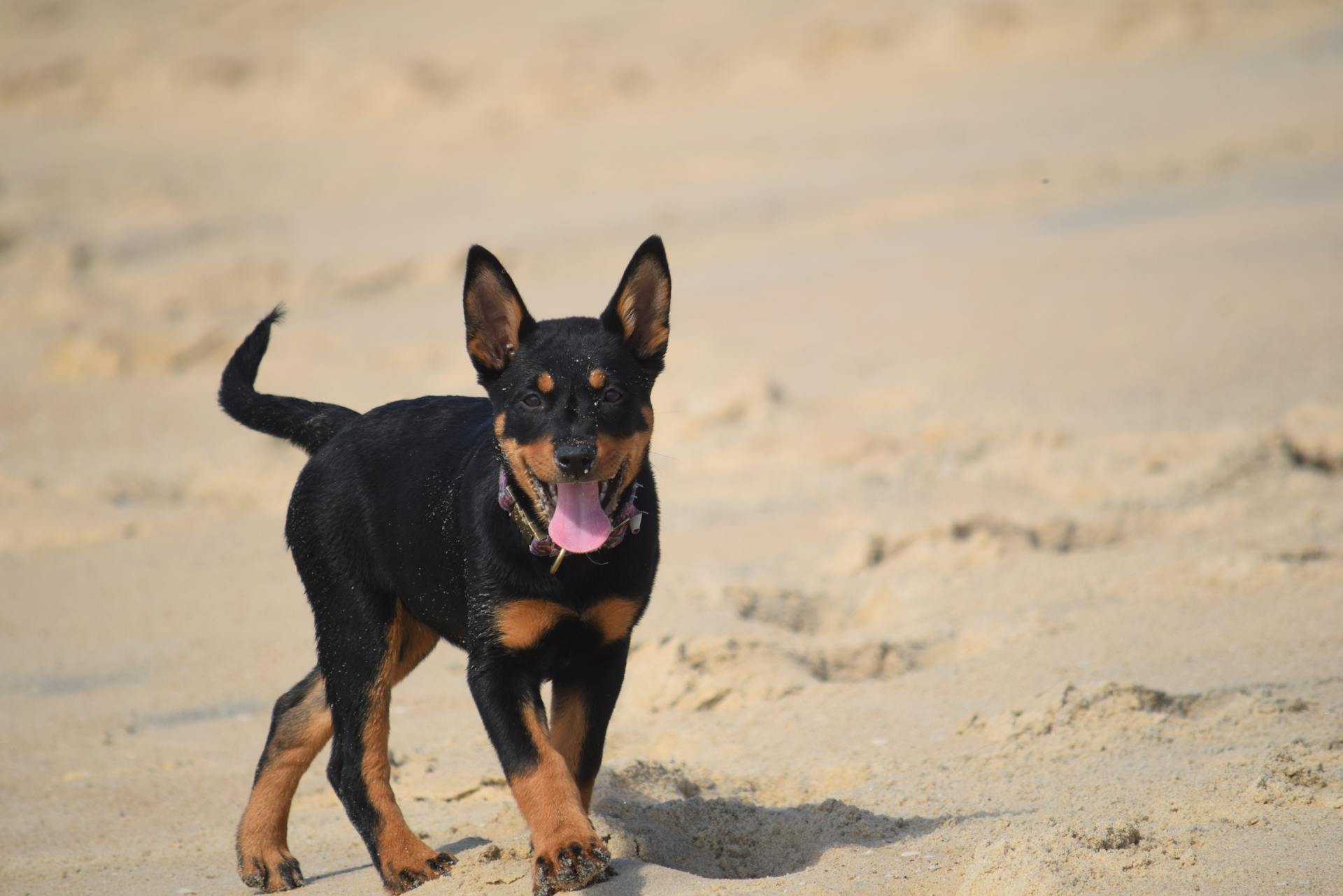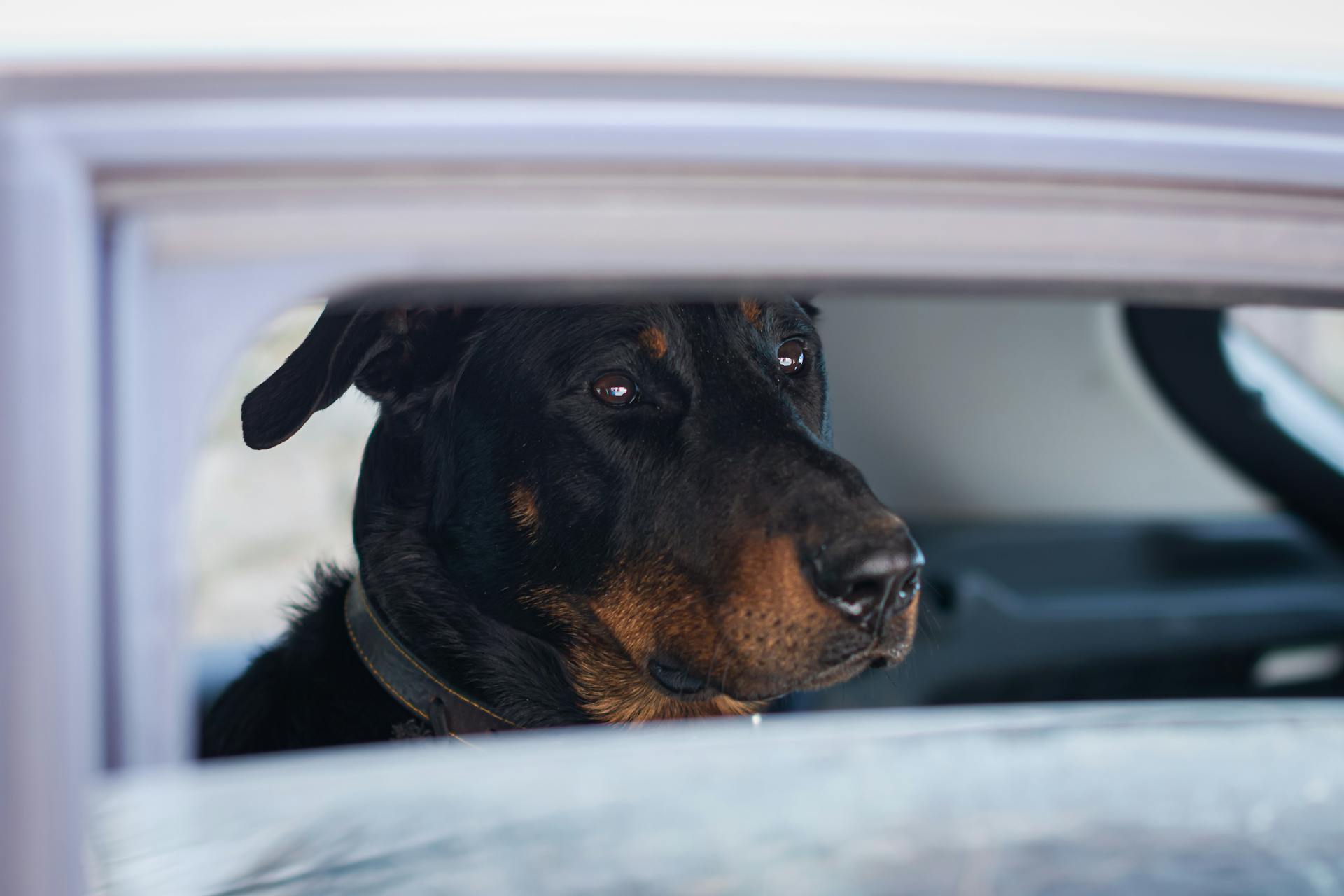
Raising a Beauceron requires attention to its unique characteristics and needs. The breed's intelligence and trainability make it a great companion for active families.
A Beauceron typically weighs between 70 and 110 pounds. Its short, dense coat requires minimal grooming.
Their high energy levels mean they need regular exercise and mental stimulation. A daily walk and playtime can help burn off excess energy.
With proper training and socialization, Beaucerons can thrive in a variety of living situations.
History
The Beauceron breed has a rich history that spans centuries. It originated in France and was relatively unknown outside its native country until recently.
The Beauceron is a cousin of the Briard breed. Before the French Revolution, both breeds were used mainly as livestock guarding dogs.
After the French Revolution, the breed developed into a herding dog. This change in purpose led to the breed's evolution over time.
The Beauceron wasn't recognized as a distinct breed until the late 19th century. This was when a clear distinction was made between the long-haired Briard and the short-haired Beauceron.
The Beauceron was recognized by the United Kennel Club in 1994.
Physical Characteristics
The Beauceron's physical characteristics are truly impressive. They have a powerful build with a strong, straight back and well-defined withers.
Their tails are strong at the base and carried down, forming a slight "J" shape without deviating to the right or left. The tail is an extension of the topline, and in action, it can be carried higher.
The Beauceron's head is long and well-chiseled, with harmonious lines and no weakness. The head must be in proportion with the body, with a ratio of about 40% of the height at the withers.
Their eyes are horizontal and slightly oval in shape, with a dark brown color, and the ears are set high, with the option to be cropped or natural. The ears are carried upright or half pricked, depending on the style.
Their coat is double-layered, with a coarse, dense outer coat and a fine, dense undercoat that is mouse gray in color and does not show through the outer coat. The outer coat is approximately 1½ inches long on the body and is short and smooth on the head, ears, and lower legs.
Physical Characteristics
The Beauceron is a large dog with a powerful, muscular build, and a rustic look. They have a strong, straight back and well-defined withers.
Their chests are wide and deep, descending to the elbow, and their girth is greater than their height at the withers by approximately 20%. The withers are well marked, and the back is straight.
Beaucerons have high-set ears that may be cropped or natural, and their eyes are horizontal and slightly oval in shape. The eyes must be dark brown, never lighter than dark hazel, with the exception of harlequin-colored dogs, which can have walleye.
Their heads are long and well-chiseled, with harmonious lines without weakness. The head must be in proportion with the body, measured from the tip of the nose to the occiput, and is about 40% of the height at the withers.
The length of the body from the point of the shoulder to the point of the buttock is slightly more than the height of the dog at the withers. The chest is wide, deep, long, and descends to the point of the elbow.
Beaucerons have a distinctive tail that is strong at the base, carried down, and descending at least to the point of the hock, forming into a slight "J" without deviating to the right or to the left.
A unique perspective: Bernese Mountain Dog Breed Standard
Forequarters
The Beauceron's forequarters are a crucial aspect of its physical characteristics, and they play a significant role in determining the dog's ability to work and its resistance to fatigue.
The shoulder blades are moderately long and sloping, which contributes to the dog's effortless movement.
The construction of the forequarters is of the utmost importance, determining the dog's ability to work and its resistance to fatigue. The legs are vertical when viewed from the front or in profile, which allows for efficient movement.
The shoulders are moderately long, muscular but not loaded, with good layback. This allows for a smooth and agile gait.
The feet are large, round, and compact with black nails. The pads are firm yet supple, providing traction and support for the dog's movements.
Additional reading: Standard Pomeranian Dog
Coat
The Beauceron's coat is a notable feature of the breed. It's double-coated, meaning it has two layers of fur.
The outer coat is coarse, dense, and flat lying, typically around 1½ inches long on the body. The undercoat, on the other hand, is fine, dense, and downy, with a mouse gray color that doesn't show through the outer coat.

The coat on the head, ears, and lower legs is short and fine. This is in contrast to the longer hair around the neck and the tail, which is lightly fringed.
The undercoat is short, fine, dense, and downy, with a mouse gray color that doesn't show through the outer coat. This is a key characteristic of the Beauceron's coat.
The Beauceron's coat is exhibited in its natural condition, with no trimming allowed. This means you'll see the dog's coat in its natural state, without any artificial styling or grooming.
Check this out: Short Standard Poodle Cuts
Characteristics
The Beauceron's personality is quite endearing. He's a gentle breed that exudes confidence and self-assurance.
One of his defining characteristics is an open and candid expression, making him a joy to be around. His fearless nature is a testament to his bravery.
This breed must never appear mean, timid, or worried, which is a relief for potential owners who want a calm companion.
Gait
When evaluating a sheepdog's gait, it's essential to look for fluid and effortless movement. This means covering ground with long, reaching strides, often described as an extended trot.
Strong, supple movement is crucial for a sheepdog, and any clumsiness or inefficiency in the gait can be a major issue.
A different take: Shetland Sheepdog Breed Standard
Temperament and Behavior
Beaucerons are confident and self-assured, never displaying mean behavior. They have a gentle nature that makes them a joy to be around.
While they may be reserved with strangers, they're loyal and affectionate with their families, often going back to cuddling with their owners after warning off intruders with a bark.
These fearless and highly-spirited dogs are best suited for wide open spaces rather than big cities, where their energy and instincts can thrive.
They're not timid or worried, and their innate protective instincts make them excellent watchdogs that will alert you to potential threats.
Care and Maintenance
Beaucerons are relatively low-maintenance when it comes to grooming. Brush them at least once per week to remove dead hair.
Regular dental care is essential for Beaucerons, which includes at-home teeth brushing and professional cleanings.
Standards and Recognition
The Beauceron is a dog of harmonious proportions, strong, with a short coat.
Height ranges from 65 to 70 cm for males and 61 to 68 cm for females.
A powerful dog with a solid bone structure and well-developed muscles.
The head is rather long, with a frank look expressing liveliness and brightness.
Natural ears droop, and the tail is long, forming a slight hook in the end.
The most common color is "black and tan", with tan markings on the legs, muzzle, and chest.
A second variety, "harlequin", has a coat with black and grey (blue) hair in equal parts, with tan markings.
The Beauceron is a faithful dog, affectionate and loving towards family.
Anything less than double dewclaws on each rear leg is not acceptable.
You might enjoy: Black Standard Poodle
Training and Ownership
Training a Beauceron requires a structured approach, as these dogs are intelligent and quick to learn new things. Consistency is key, as they can pick up on habits and behaviors easily.
Beaucerons need guidance to channel their boundless energy, which can be redirected in positive directions with proper training. Harsh physical corrections are not an effective way to train them.
Be firm, fair, and consistent in your training methods, as punitive approaches can be counterproductive. This breed does not respond well to harsh corrections.
Positive reinforcement and clear boundaries are essential for teaching your Beauceron new skills and behaviors.
You might enjoy: Training a Poodle Standard
Conclusion
The Beauceron standard is a precise guide, especially when it comes to teeth and dewclaws.
A judge should respect the standard to avoid serious mistakes in judging the Beauceron.
The standard doesn't cover all points in this article, but it does highlight essential ones to avoid overlooking main faults.
New judges and experienced ones will find guidelines in this text to improve their judging skills.
Reading this text will give judges the confidence to judge the Beauceron accurately.
Frequently Asked Questions
What is a Beauceron ear standard?
A Beauceron's uncropped ears are flat, short, and half the length of the head, not plastered against the cheeks. They are either half-pricked or drop-ears, with a distinct shape that sets them apart.
What is the Beauceron standard UKC?
The UKC Beauceron standard describes a large, muscular dog with a balanced and harmonious build, emphasizing effortless movement and a fearless demeanor. Its rustic appearance is characterized by a powerful physique without heaviness.
What breeds make up a Beauceron?
The Beauceron's origins are linked to the Briard, and its name was chosen to differentiate it from this cousin breed. The Beauceron's exact ancestry is unclear, but it may also share a connection with the Doberman Pinscher.
Is Beauceron a rare breed?
No, Beaucerons are not considered a rare breed. They are a relatively well-established and recognizable breed.
Featured Images: pexels.com
